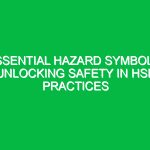Introduction
In today’s world, the significance of hazardous signs and symbols has never been more critical. These visual indicators are essential components of health, safety, and environmental (HSE) practices across various industries. They serve as the first line of defense against accidents and injuries, alerting workers and the public to potential dangers. For HSE professionals, understanding these signs and symbols is fundamental, as they help ensure compliance with Safety Regulations and promote a culture of Safety in the workplace.
The relevance of hazardous signs and symbols extends beyond mere compliance; they are instrumental in conveying crucial information quickly and effectively. When communicated clearly, these signs can prevent accidents and save lives. In this article, we will explore the essential hazardous signs and symbols that every HSE professional must know, delving into their meanings, applications, and the regulations that govern them.
Understanding Hazardous Signs and Symbols
Hazardous signs and symbols are standardized visual cues that communicate safety information related to hazardous conditions, materials, or practices. They are designed to be universally understood, transcending language barriers. These signs can be found in various settings, including workplaces, construction sites, laboratories, and public areas, each serving a specific purpose.
The International Organization for Standardization (ISO) and the Occupational Safety and Health Administration (OSHA) have established guidelines to standardize these signs. Understanding these guidelines and the meanings behind the signs is crucial for HSE professionals to foster a safe working Environment.
Types of Hazardous Signs and Symbols
Hazardous signs and symbols can be classified into several categories, each with its specific purpose. Below, we will discuss the most common types and their meanings.
1. Warning Signs
Warning signs typically feature a yellow background with a black symbol or text, indicating a potential hazard. These signs alert individuals to situations that could cause injury or damage. Common examples include:
- Caution: Wet Floor – This sign indicates a slipping hazard due to wet surfaces.
- Caution: High Voltage – A warning about the potential for electric shock.
- Caution: Flammable Material – Indicates the presence of materials that can ignite easily.
2. Prohibition Signs
Prohibition signs are characterized by a red circle with a diagonal line crossing through a symbol, indicating that certain actions are not permitted. Examples include:
- No Smoking – Indicates areas where smoking is strictly forbidden.
- No Entry – Signifies restricted access to specific areas.
- No Food or Drink – Commonly found in laboratories where contamination is a concern.
3. Mandatory Signs
Mandatory signs are marked with a blue circle, conveying instructions that must be followed. These signs are crucial for maintaining safety protocols. Examples include:
- Wear Safety Goggles – A directive to protect eyes from hazardous materials.
- Use Hearing Protection – Indicates areas with high noise levels where ear protection is required.
- Wash Hands – Common in food preparation areas and labs, this sign emphasizes hygiene.
4. Emergency Information Signs
Emergency information signs provide critical information about emergency Procedures and exits. These signs often feature green backgrounds with white symbols or text. Some examples are:
- Emergency Exit – A sign indicating the nearest evacuation route.
- First Aid Station – Directs individuals to the location of first aid supplies.
- Fire Extinguisher – Indicates the location of firefighting equipment.
5. Hazard Symbols
Hazard symbols are graphical representations that indicate the type of hazard associated with a material or substance. These symbols are often found on chemical labels and include:
- Skull and Crossbones – Indicates toxic substances that pose a severe health risk.
- Flame – Signifies flammable materials.
- Corrosion – Indicates that a substance can cause skin Burns or eye damage.
Importance of Hazardous Signs and Symbols in HSE
The implementation of hazardous signs and symbols plays a pivotal role in promoting safety within the HSE framework. Here are some of the key Benefits:
1. Enhancing Safety Awareness
Hazardous signs and symbols serve as constant reminders of potential dangers in the workplace. By consistently reinforcing safety messages, these signs help cultivate a safety-conscious culture among employees. For instance, in a manufacturing plant, the presence of “Caution: Heavy Machinery” signs can prompt workers to remain vigilant and follow safety protocols.
2. Reducing Workplace Accidents
Statistical evidence suggests that workplaces equipped with clear and visible hazardous signs experience fewer accidents. For example, a case study conducted at a chemical plant revealed that the introduction of proper Hazard Symbols significantly reduced the number of chemical exposure incidents. This underlines the importance of adhering to safety Standards and regulations.
3. Facilitating Emergency Response
In emergency situations, time is of the essence. Hazardous signs and symbols provide crucial information that can expedite emergency response efforts. For instance, clear signage indicating the location of fire exits or first aid stations can save lives during a crisis.
4. Compliance with Regulations
Regulatory bodies such as osha and the Environmental Protection Agency (EPA) mandate the use of hazardous signs and symbols in various industries. Compliance with these regulations not only avoids legal repercussions but also enhances the overall safety of the workplace. HSE professionals must stay informed about these regulations to ensure their organizations are compliant.
Regulations and Standards Governing Hazardous Signs and Symbols
Understanding the regulations governing hazardous signs and symbols is essential for HSE professionals. These regulations vary by country and industry but often align with international standards to ensure consistency. Some of the key regulations include:
1. OSHA Standards
In the United States, OSHA has established standards that dictate the use of hazardous signs and symbols. These regulations require employers to provide a safe working environment and to use appropriate signage to inform employees of potential Hazards. Familiarity with OSHA standards is crucial for HSE professionals operating in the U.S. workforce.
2. ISO Standards
The ISO has developed international standards for Hazard Communication, including the use of pictograms and symbols. ISO 7010, for example, is a standard that defines safety signs used in workplaces around the world. HSE professionals should be aware of these standards to ensure their organizations remain compliant on an international level.
3. National and Regional Regulations
In addition to OSHA and ISO standards, various countries have their own regulations governing hazardous signs and symbols. For instance, the European Union has established the Globally Harmonized System (GHS) for chemical labeling, which includes specific hazard symbols for various substances. HSE professionals must familiarize themselves with the regulations applicable to their specific region and industry.
Best Practices for Implementing Hazardous Signs and Symbols
To maximize the effectiveness of hazardous signs and symbols, HSE professionals should adhere to several Best Practices:
1. Conduct a Hazard Assessment
Before implementing signs, conduct a thorough hazard assessment to identify potential risks in the workplace. This assessment will inform the selection of appropriate signs and symbols that address the specific Hazards present.
2. Use Standardized Signage
Utilize standardized signs and symbols that comply with OSHA and ISO regulations. This ensures consistency and clarity in communication, reducing the likelihood of misunderstandings.
3. Ensure Visibility
Signs should be placed in locations where they are easily visible to all employees and visitors. Ensure that they are well-lit and free from obstructions.
4. Provide Training
Regular training sessions should be conducted to educate employees about the meanings of hazardous signs and symbols. This training fosters a culture of safety and empowers employees to take appropriate actions in hazardous situations.
5. Review and Update Regularly
As workplace conditions change, it is vital to review and update hazardous signs and symbols regularly. This practice ensures that the signage remains relevant and effective in communicating risks.
Conclusion
In conclusion, hazardous signs and symbols are indispensable tools for HSE professionals. They not only enhance safety awareness and compliance with regulations but also play a crucial role in reducing workplace accidents and facilitating emergency responses. By understanding the various types of signs, their meanings, and the regulations governing their use, HSE professionals can create a safer environment for all.
As you navigate the complexities of health, safety, and environment practices, remember the critical role that these signs and symbols play in promoting a culture of safety. Whether you are an HSE manager, safety officer, or a worker on the front lines, familiarity with hazardous signs and symbols will empower you to contribute to a safer workplace. Let us ensure that safety remains a priority, one sign at a time.


